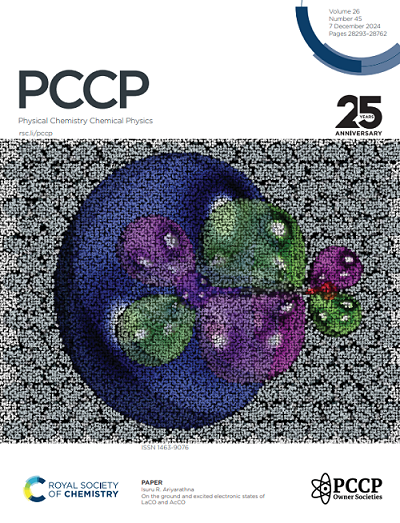Reaction Mechanism of Silylation of C−O Bonds in Alkyl Ethers over Supported Gold Catalysts: Experimental and Theoretical Investigations
IF 2.9
3区 化学
Q3 CHEMISTRY, PHYSICAL
引用次数: 0
Abstract
The reaction mechanism of α-Fe2O3-supported Au-catalyzed silylation of ether C(sp3)–O bonds by disilane is investigated using both experimental and computational approaches. The experimental study reveals that the ether activation is the rate-determining step in the silylation of C(sp3)–O bonds and that this reaction proceeds via the SH2-type mechanism involving radical species. DFT calculations demonstrate that the Si–Si bond cleavage in disilane occurs at the interface between Au cluster and α-Fe2O3 support with a low activation energy and that the subsequent attack by silyl radicals on the ether involves an energy barrier consistent with the experimental results. These investigations provide valuable insights into the unique reaction mechanism of ether C(sp3)–O bond activation, which could serve as a basis for the development of novel supported metal catalyst systems.负载型金催化剂上烷基醚C−O键硅化反应机理:实验与理论研究
采用实验和计算两种方法研究了α- fe2o3负载金催化的乙醚C(sp3) -O键硅基化反应机理。实验研究表明,醚活化是C(sp3) -O键硅基化的速率决定步骤,该反应是通过涉及自由基种类的sh2型机制进行的。DFT计算表明,二硅烷中Si-Si键的断裂发生在Au团簇与α-Fe2O3载体之间的界面处,其活化能较低,随后硅基自由基对醚的攻击涉及一个能垒,与实验结果一致。这些研究为探讨乙醚C(sp3) -O键活化的独特反应机理提供了有价值的见解,为开发新型负载型金属催化剂体系奠定了基础。
本文章由计算机程序翻译,如有差异,请以英文原文为准。
求助全文
约1分钟内获得全文
求助全文
来源期刊

Physical Chemistry Chemical Physics
化学-物理:原子、分子和化学物理
CiteScore
5.50
自引率
9.10%
发文量
2675
审稿时长
2.0 months
期刊介绍:
Physical Chemistry Chemical Physics (PCCP) is an international journal co-owned by 19 physical chemistry and physics societies from around the world. This journal publishes original, cutting-edge research in physical chemistry, chemical physics and biophysical chemistry. To be suitable for publication in PCCP, articles must include significant innovation and/or insight into physical chemistry; this is the most important criterion that reviewers and Editors will judge against when evaluating submissions.
The journal has a broad scope and welcomes contributions spanning experiment, theory, computation and data science. Topical coverage includes spectroscopy, dynamics, kinetics, statistical mechanics, thermodynamics, electrochemistry, catalysis, surface science, quantum mechanics, quantum computing and machine learning. Interdisciplinary research areas such as polymers and soft matter, materials, nanoscience, energy, surfaces/interfaces, and biophysical chemistry are welcomed if they demonstrate significant innovation and/or insight into physical chemistry. Joined experimental/theoretical studies are particularly appreciated when complementary and based on up-to-date approaches.
 求助内容:
求助内容: 应助结果提醒方式:
应助结果提醒方式:


